The 5 Best Lightweight Rain Cycling Jackets in 2018
There’s a common Norwegian saying that goes like this,
There’s no such thing as bad weather, only bad clothes.
To stay comfortable in the rain, you’ll need a cycling jacket that comes with these 3 properties.
Breathable. Lightweight. Waterproof.
With today’s technology, you can definitely find one that looks great while meeting all 3 properties above. If you’re riding in cold weather, a winter cycling jacket will do a much better job of keeping you warm.
On this page, I’ll share with you what to look for in a good jacket and share some of the popular options available.
Waterproof Cycling Jacket Recommendations
Endura Pro SL Race Cape
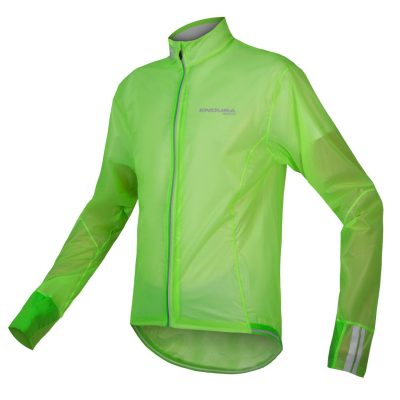
The Endura Pro SL Race Cape is made from Endura’s proprietary Exoshell fabric. It’s highly breathable, with a rating of 20,000g/m2/24 hours, which is above the average of 15,000g/m2/24 hours found in most models.
It has a snug racing cut so it’s aerodynamic without all the flapping. The translucent fabric allows for your race number to be visible through the shell, and it comes in black, white, and a high-visibility vibrant green. It also has reflective elements along with the cuffs and hems for maximum visibility. The hems are made with a microfiber hem gripper so it fits snugly and securely.
For those weight weenies, the Endura Pro SL Race Cape is extremely lightweight and packs down into its own pouch, so it’s also easy to keep in a pocket. The elastic cuffs fit snugly while still allowing room for your hand to push through. It has a slightly longer tail to protect against road spray and a padded collar and storm flap for comfort.
More importantly, the Endura Pro SL Race Cape is designed to stretch in all the right places so you can cycle with ease.
- Pros : Breathability rating is above the average rain jacket.
- Cons : Very snug fit only suits cyclist with a slim body shape.
Sportful Hotpack No Rain Jacket
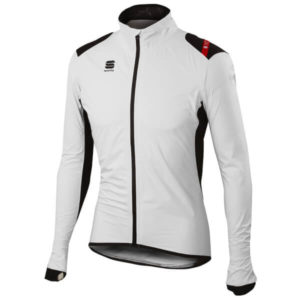
The Sportful Hotpack NoRain Jacket is lightweight, waterproof, and weighs only 140g for Large size. You can easily pack it down into its own small pouch that fits easily into your back pocket.
Its sleek fit keeps it from flapping in the wind and slowing you down. The outer layers are made from Superleggera DWR fabrics that repel water easily. Also, it’s also windproof to keep you safe from the elements and wind chill.
There are mesh inserts on the back and side panels to make it breathable but without compromising its waterproofing capabilities. The taped seams are reinforced to keep out water and it has elastic around the wrists for a tight fit along with a thumb loop. The fabric is designed to be wrinkle-free and it has a longer tail in the back to keep you dry.
There is an extra stretch in the areas where you need it, a waterproof zipper in the front, and reflective elements for safety. It is also available in women’s specific variants.
- Pros : Compact and can be easily packed down into its own small pouch.
- Cons : Breathability is average. You’ll get wet from inside if you’re riding hard.
Altura Pocket Rocket 2
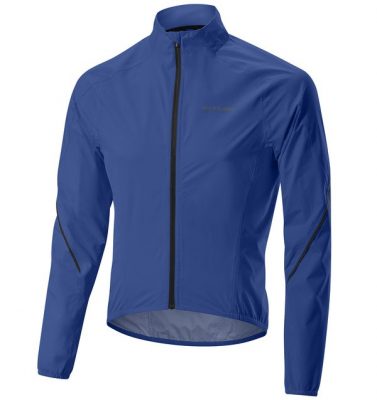
This Altura Pocket Rocket 2 is made with Altura’s ErgoFit technology, making it cut for maximum comfort while you’re riding in the rain.
The outer layer is also highly reflective, which is an important consideration when you’re riding in poor weather conditions or dark areas. The fabric is waterproof, windproof, and breathable. Seams are well-taped so there’s no place for water to leak in, keeping you dry on the wettest days.
It comes in a variety of fun colors and has a slightly longer tail for your comfort and protection. There’s also a small zippered pocket in the back so you can keep important items with you when you’re on the go.
Size-wise, it packs down into a zippered pocket so you can keep it on hand for emergencies and it weighs around 180g.
- Pros : Semi-fitted, so it’s suitable for racing or casual cycling
- Cons : No waist flap at the back.
Castelli Idro 2
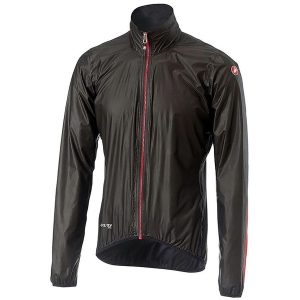
Castelli is a well-known name when it comes to racewear. The Castelli Idro 2 is a two-layer waterproof jacket that’s lightweight and durable.
Made from Gore-Tex’s latest Shakedry fabric, it’s the gold standard of rain jackets and backed their Guaranteed to Keep You Dry promise. The Gore Tex Shakedry fabric is both waterproof and windproof, so you’ll stay just warm enough. It’s also breathable, so you’ll stay dry no matter how hard you cycle. A large size weighs just 107g and folds down to fit easily into your jersey pockets.
The race-fit jacket fits nicely over your jersey and includes exterior zippers so you can access your jersey pocket. It also includes a long drop tail and high neck to help keep you dry in the wettest weather.
The seams are taped to prevent water from leaking through. The Castelli Idro 2 has reflective strips at the back panels for safety purposes. It includes a waterproof zipper and anatomic wrist closure.
More importantly, there is a women-specific variant of the Castelli Idro 2.
- Pros : Very breathable and fully waterproof.
- Cons : Material is thin and flimsy and prone to tears.
Gore C5 Active Shell Jacket
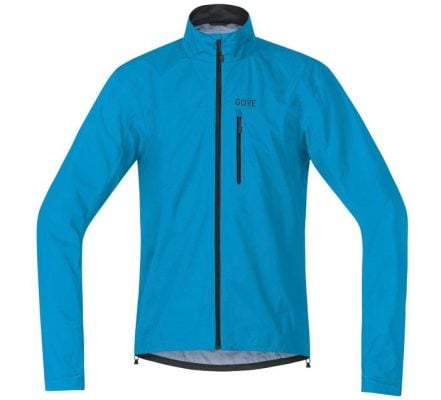
The GoreTex Active Shell Jacket is comfortable and stylish that will definitely keep you dry in the rain. It’s highly breathable while still being windproof and waterproof. It is designed with a looser fit so it’s suitable for those who prefer layering.
The hem is adjustable with a cord stopper and drawstring, giving you the ability to customize the fit even further. The cuff is also adjustable and the piping on the jacket is reflective so you’re easily seen.
It runs long in the back to keep you protected from splashing. There is a zippered stow pocket in the back so you can carry needed items with you. The hood also stashes away in the collar.
For those who are fashion-minded, the GoreTex Active Shell Jacket comes in a variety of bright colors, in black, blue, red, and yellow options. Care-wise, it’s easy. Just wash it on cold and tumble dry on low. You can even iron it on a low setting.
- Pros : Constructed with the highest quality materials – GoreTex.
- Cons: Expect to pay a little more.
Cycling Rain Jackets Buying Guide
1. Types of Fabrics Used
The most important consideration when you’re deciding on a waterproof cycling jacket is the type of fabric. They are either made from laminate fabrics or they’re treated with Durable Water Repellant or DWR.
Laminated Jackets
These are multi-layered. The inner layer is porous to release moisture from sweating, but the pores are too small to allow water droplets from rain to come through.
The outer layer typically has a DWR treatment.
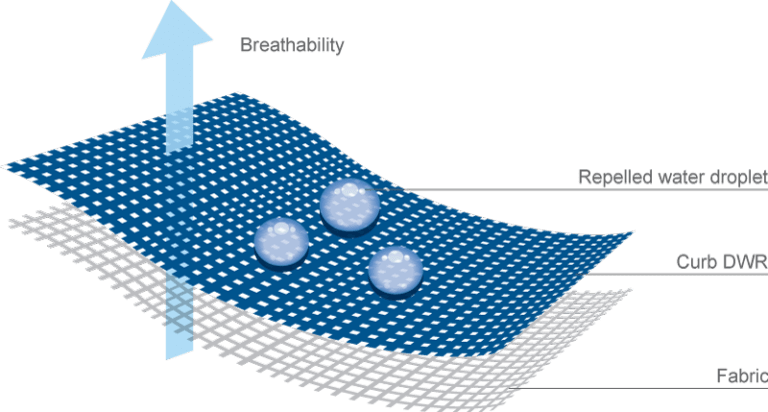
Durable Water Repellant
DWR treatments force water to retain its surface tension, so the water beads and slides off instead of soaking through the fabric.
The fabric stays breathable because the treatment doesn’t fill gaps in the fabric; it makes the fabric fibers bond.
2. Waterproofing Ratings
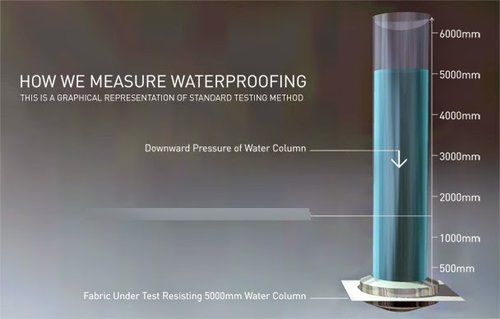
Not all waterproof jackets are created equal and they all perform differently.
Clothing manufacturers (not all of them) express the waterproofing capabilities in terms of mm. Let’s imagine you put a square 1″ x 1″ tube over a piece of waterproof fabric, you’ll need to fill the tube up to 10,000mm (10 meters) in height before water starts leaking through.
The higher the number, the better the waterproofing capabilities.
According to industry standards, here are the waterproof ratings explained.
- Less than 10,000mm. Minimal protection for activities like running and hiking in intermittent light rain and snow.
- 10,000 – 15,000mm. Medium protection for activities like hiking and skiing in moderate rain, snow, and wind.
- 15,000 – 20,000mm. Excellent protection for most activities in moderate rain, snow, and wind, with intermittent heavy rain and snow.
- More than 20,000mm. Extreme protection for persistent heavy rain, heavy snow, high winds, and very wet environments. Ideal for activities like mountaineering, ice climbing, backcountry skiing, and kayaking.
3. Breathability Ratings
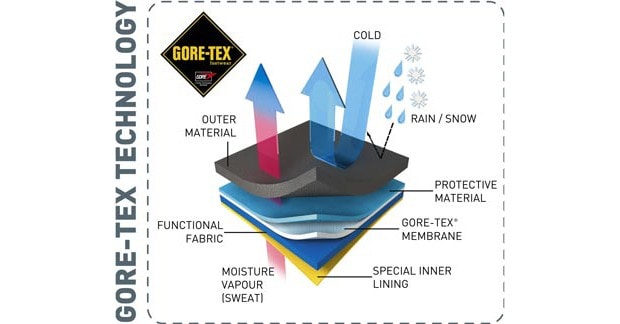
No one wants to be covered in sweat while they cycle. Waterproof jackets may have an inner wicking layer as well as vents to help keep you dry.
They typically come in 2.5 to 3 layers and may have additional ventilation in areas where you’re most likely to sweat, such as under the arms.
Some manufacturers (again, not all) do provide breathability ratings.
It’s a number expressed in terms of how many grams of water vapor can pass through a square meter of fabric in 24 hours.
4. Size and Fit
The type of fit you need depends on the type of cycling you do.
If you’re looking for speed, you’ll want a more aerodynamic jacket with a slimmer and snug fit.
If you’re spending long days on the road, you might want something with a looser fit so you can wear layers underneath.
Some also include details like a longer tail and thumb loops, which are great extra features to have.
5. Packability
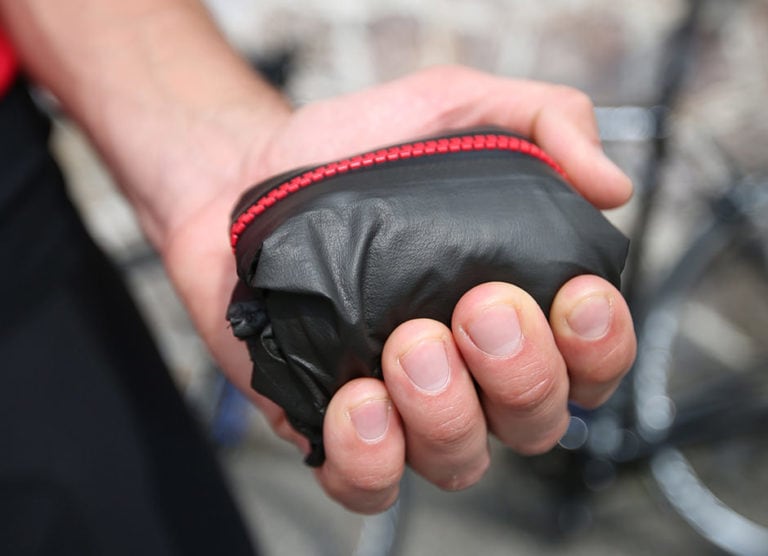
If you ride in unpredictable weather conditions, or if you’re expecting changeable weather during the ride, you may want a jacket that can be easily packed up and fit into the back pockets.
Some can be folded down to be quite small and have their own little pouch, while others are bulkier and might not be as easy to store when the weather changes.
Frequently Asked Questions
1. How waterproof should my cycling rain jacket be?
I’d recommend looking for those that are rated between 10,000 to 20,000mm.
With these, you’re looking at medium to excellent protection from heavy downpours when you’re out riding.
Having said that, it’s also important to have excellent seam taping to ensure water doesn’t seep through the tiny holes made by needles during the sewing process.
Otherwise, the highest waterproof-rated jacket wouldn’t be able to keep you dry.
2. How breathable should my cycling jacket be?
A layer of warm, moist air sits between the jacket’s inner layers and your underlayers.
A very breathable cycling jacket is not ideal especially in cold weather as it could the warm air to leave your body, leading to heat loss causing you to feel cold.
At the same time, it should also retain some of this warm air to keep you warm from the inside.
Hence, there is a very fine balance between breathability and keeping warm. Too much of either is not ideal.
You’ll want to look for a jacket rated around 10,000 to 15,000g/m2/24 hours for cycling. The larger the number, the more breathable the fabric is.
3. How can the rain jacket both waterproof and breathable at the same time?
A typical waterproof jacket is made up of 3 layers.
- Outer layer, called the Face Fabric, protects the inner layers and provides stylish looks. It’s not waterproof but is treated with a DWR (Durable Water Repellent) solution not to hold up water on the surface.
- Middle layer is called the membrane. Its job is to keep the water out completely. What’s unique about this layer is that it has holes that are too tiny to let water in a while, having holes that are large enough for water vapor to escape, keeping you dry from the inside.
- Innermost layer, the mesh liner, provides comfort while also providing sweat-wicking capabilities.
4. What is DWR and how does it work?
DWR stands for Durable Water Repellent.
It’s a chemical treatment used on most outdoor clothing to make them waterproof. With DWR treatment, causes water to bead up and roll off the fabric which would otherwise add weight causing discomfort.
Take note that the DWR treatment from the factory can wear off over time due to exposure to outdoor elements, oil, and dirt. This causes the rain jacket to be no longer waterproof.
However, this can be easily treated at home by yourself to reactivate the DWR properties. You can buy aftermarket DWR sprays like Grangers and Nikwax and spray them on the jacket after washing.
Alternatively, you can tumble dry them in a warm, gentle cycle after washing.
Read More : How to Care for Your Expensive Cycling Kits
5. What is GoreTex?
GoreTex is a waterproof and breathable fabric found in outdoor activity clothing invented by Gore. It’s invented in 1969 and a registered trademark of W.L. Gore and Associates.
Gore-Tex fabrics have the capabilities to repel water drops while allowing water vapor to exit.
Since its inception, there are now various variations of GoreTex such as GORE-TEX® Pro, GORE-TEX® Active, and just the standard GORE-TEX®.
You’ll notice that most premium waterproof cycling jackets come with Gore-Tex fabrics, while low to mid-range jackets usually use the manufacturer’s own proprietary waterproof fabrics.
Author Recommended Reads
